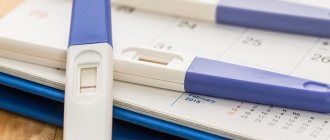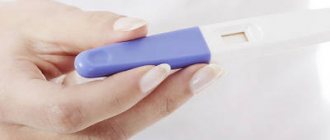A pregnancy test is a simple, accessible diagnostic method that is used from the first day of missed menstruation. It reacts to the appearance in the urine of the “pregnant” hormone gonadotropin, produced by the chorion membrane of the embryo.
Having detected it in the urine, the test shows two stripes or a cross. If there is no gonadotropin, one strip. Statistics say that the reliability of home diagnostic results is high, but not 100%, so cases where the test is negative and pregnancy has occurred are not uncommon.
Can the test fail to show pregnancy?
Manufacturers of the most accurate and sensitive products provide a 99% guarantee, leaving 1% error. They allow for the possibility of errors due to violation of storage conditions, expiration date, sensitivity of the reagent and other factors.
Erroneous data can be shown either by the most expensive and advertised product, which has many good reviews, or by the most affordable one. Some manufacturers claim that their products are highly sensitive and detect pregnancy as low as 10 mIU/ml.
In fact, the test can really “catch” gonadotropin in urine when its amount is not less than 20-25 mIU/ml.
If there are doubts about the reliability of the result, it is worth purchasing another test. The most accurate result is obtained by testing the blood for the content of the hormone hCG. It is carried out in laboratory conditions. The obtained data is checked against a control table. It determines the gestational age by week.
How to take a test to see if you are pregnant?
To correctly diagnose the onset of conception, it is important to follow clear instructions and recommendations :
- test exclusively the first portion of morning urine ;
- collect urine in sterile and dry containers, since water and other substances can mix with the reagent and give an incorrect result;
- when using a test strip, it must be lowered into the liquid only to the indicated mark and held for the strictly recommended time;
- after removal, the test is placed on a horizontal surface;
- when reading the result, only the data that was received in the first five minutes ;
- when using a jet or electronic test, it must be placed under a stream of urine during morning urination;
- the result is calculated in the same way as when using a classic test strip;
- with a cassette study, a drop of morning urine is placed in a special compartment using a pipette , and the result is obtained in 3-5 minutes;
- It is necessary to do home tests only on the first day of your expected period.
If these rules are followed, the chance of getting a negative result during pregnancy is virtually zero . But if you are sure that you are pregnant, but the tests did not show the result. You should urgently contact a gynecologist or an ultrasound room. Timely treatment will allow you to exclude an ectopic or frozen pregnancy, which can lead to severe bleeding and a threat to the patient’s life.
Why does this happen - possible reasons
Not only the quality of conventional test tools and their sensitivity affect the reliability of the study.
The reasons may lie in the woman’s health status, compliance with diagnostic conditions, and the time of its implementation.
Early diagnosis
An unreliable test result is often associated with early diagnosis. Women who have undergone IVF or artificial insemination are often in a hurry to find out the results, as well as those couples who have only recently begun to “try” for the birth of a baby and are looking forward to the appearance of the coveted stripes.
Haste (examination at 5-6 dpo - the day after fertilization) in obtaining the desired results is a bad help. For the test to show a reliable result, the concentration of the hormone in the urine should approach 25 mIU/ml. If its level is lower, the test tools do not detect hCG, showing a negative result, even if the woman is really about to become a mother.
It is recommended to repeat the procedure the next day or every other day. If conception has taken place and the baby is developing, the test will show two stripes, and a laboratory blood test will confirm an increase in the amount of human chorionic gonadotropin.
The optimal time to use the test is 1-2 days after a missed period. There are cases when a woman found out about an “interesting situation” several days before the delay began, but this is the exception rather than the rule.
Bad urine
The quality of your urine is an important factor in determining the reliability of the test. Her condition is affected by diseases of the excretory system, due to which the amount of protein in the urine increases, which distorts the diagnostic results.
If a woman with diseases of the genitourinary system is pregnant and there are indirect signs of this phenomenon (early toxicosis, deterioration of health, drowsiness, absence of menstruation), instead of a positive result, the test tool will show a negative result.
It is recommended to do the test in the morning, when the content of hCG in urine is maximum. If last night the girl drank a lot of liquid, then this morning the reliability of the result will be questionable. To obtain accurate information, it is advisable to repeat the procedure every other day, monitoring the amount of liquid you drink per day.
Violation of the rules for using the test
Every girl knows how to use the test system. Despite the similarity of the principle of “work,” test materials from different manufacturers have their own characteristics, so before using them you need to read the instructions.
Some are placed in a container with urine only in the morning, others are placed under the stream at any time of the day, and for others you need to apply a couple of drops into a special cassette. By violating the instructions that manufacturers accompany their products, it is easy to make a mistake and get nervous out of nowhere.
When purchasing a test, make sure it is fresh and the packaging is intact. If you buy it from a gas station or other location other than a supermarket, consider whether it was stored properly.
If in doubt, delay your purchase. Test materials are equivalent to medical diagnostic tools and must be purchased at a pharmacy, where they are always in stock, stored correctly and monitored for expiration dates.
Pathologies of the excretory system
Diseases of the excretory system often distort the diagnostic result. They increase the level of protein in the urine, affect kidney function, enhancing or, conversely, slowing down reabsorption processes, which affects the content of human chorionic gonadotropin in urine.
Cystitis is a frequent companion to early pregnancy. Because of this disease, the test strip will only have one line on the test strip instead of two.
Deviations in pregnancy
One strip in the test system during pregnancy occurs with various pathologies of bearing a baby.
Ectopic pregnancy. If the embryo is not implanted in the uterine cavity, but in one of its tubes, in the ovary or cervix, chorionic gonadotropin is produced in smaller quantities than during its uterine development.
The embryo grows and develops, but this is a pathological process that threatens the life and health of the woman. Such a pregnancy appears on the test as one bright stripe, or two stripes: one bright and clear, the second pale and barely noticeable.
If after a day there are again two lines on the test strip: bright and weak (the color intensity of the second strip has not changed), it is likely that the embryo is developing outside the uterine cavity.
It is necessary to visit the gynecologist's office if after a week the stripes do not become equally bright. There is no need to panic, it is possible that the pregnancy is uterine, but little time has passed since conception (which is very likely if the girl does not know the exact date of ovulation or the date of conception), so the stripes did not have time to turn purple.
An accurate sign of ectopic fetal development is pain localized at the site of its attachment. It is intense, does not go away with painkillers and is not similar to the pulling or aching sensations in the lower abdomen that are characteristic of normal pregnancy.
Freezing of the fetus. Sometimes the pregnancy of a baby ends before it has even begun. Predisposing factors include stress, alcohol, colds, and various chronic diseases. However, miscarriage occurs in an absolutely healthy woman who already has one or more children.
The fact that the child has stopped developing may be indicated by spotting or pulling sensations in the lower abdomen. Immediately after termination of pregnancy, the production of hCG stops, but for some time it remains in the blood and urine. An ultrasound shows a fertilized egg that is no longer developing.
Early miscarriage. It happens that the pregnancy of a baby is spontaneously interrupted literally in the first days from the moment of conception. Characteristic signs are nagging pain in the lower abdomen, a slight delay and heavy, painful menstruation, which is unusual for a girl.
Miscarriages are not uncommon during lactation. New breastfeeding mothers, especially those who have recently given birth, often rely on “natural contraception,” breastfeeding.
During this period, women actively produce prolactin and oxytocin. Regular breastfeeding with strict adherence to a three-hour interval between breastfeeding prevents conception.
Mothers are not always able to strictly adhere to a feeding regimen that does not allow them to become pregnant, but they remain confident that “nothing will happen.” Therefore, families often grow up with babies of the same age, but it also happens that the embryo dies at a very early stage.
After miscarriages, gynecologists recommend taking birth control pills. Many manage to become mothers already in the first cycle after completing their course of treatment.
Poor quality test
When buying a test product at a pharmacy, it is impossible to determine its quality. Even the most sensitive and expensive electronic test systems, Evitest or Clearblue, no matter how much they cost, do not guarantee extremely accurate data that is beyond doubt.
Both positive and negative data are erroneous. That is, a woman who is not pregnant can see two lines on the test and vice versa, when all the signs of future motherhood are present, but the test strip denies this.
The product purchased at the pharmacy must be fresh (the expiration date is indicated on the box or sealed packaging), and the packaging itself is intact, without damage or traces of moisture.
If the test was purchased in advance and has been lying at home unused for a long time, or it is offered to you by a friend who decided to come to the rescue, it is better to purchase a new one.
What to do?
What can you do if the tests show a negative result, but you still feel symptoms of pregnancy? It depends on whether you are expecting your period or not. There is a 50/50 chance that the test could be false if you are not expecting your period yet. Wait a few days and repeat it.
You should repeat it after two or three days if the expected period of menstruation has already passed and the strip is still there. However, if your period starts and you still feel pregnant, you should wait a few days after it and test again.
There may be other reasons for missing periods if the tests are still negative. You can repeat the definition again if you want. But if this time it shows that you are not pregnant, this almost certainly means that you are. There may be other reasons for this condition that require you to see a doctor. Plus, it can be too hard to accept a negative result if you've been trying really hard to conceive.
Testing for ectopic pregnancy
An ectopic pregnancy has all the signs of a normal pregnancy. The expectant mother does not begin menstruation at the scheduled time of the month; she feels slightly nauseated and drowsy. The test strip shows a positive result.
Some experts claim that the first line on the test is bright, and the second is paler, others that both are the same in brightness. Using a pharmacy pregnancy test, it is impossible to determine exactly where the fetus is implanted: inside or outside the uterus.
The fetus, fixed outside the uterus, develops up to seven weeks, reaching the maximum permissible size for a tube or ovary. By this time, the woman suspects that something is wrong due to pain localized in a certain place.
If you do not take timely measures and do not visit the doctor's office or ultrasound, the abnormal pregnancy ends on its own. This threatens heavy bleeding and a serious shock to the reproductive system and the health of the whole body.
Why doesn't a pregnancy test show pregnancy when there is one?
Those who are interested in why a pregnancy test does not show pregnancy after a long delay cannot be answered with complete confidence, because there are several reasons. There is no mysticism here, every phenomenon has its own reason, and almost everything can be explained:
- a test with low sensitivity will not show the answer at a short stage of pregnancy;
- if you ask the pharmacy for the cheapest test kit that has expired, don’t be surprised why the test doesn’t show pregnancy (quite predictably);
- low quality goods;
- too little reagent was applied to the test strip, which does not work on the hubbub, a different concentration is needed;
- treatment with complex drugs has not been completed;
- a small level of the control hormone hCG in the blood and urine (litmus did not react to it);
- the urine into which the test is immersed is diluted (a wet glass after washing, and the day before you took diuretics or other drugs that change its concentration or hormonal levels;
- testing was not carried out according to instructions;
- there are diseases of the cardiovascular system or other pathologies in which hCG is present in the blood in insufficient quantities for the test sample;
- abnormal course of pregnancy (threat of miscarriage due to hormonal imbalance);
- ectopic pregnancy or sudden fetal death;
- the fertilized egg did not have time to descend into the uterus (“walking” through the tubes) and gain a foothold in due time;
- the test does not show pregnancy due to kidney pathology against the background of a completely favorable state of the genital area.
Advice:
If there is any discrepancy between the test results and internal sensations, you should not look on the forums for the answer to the question “why does a pregnancy test show nothing?” Please contact your local doctor regarding this.
An exact answer can only be obtained after a comprehensive examination, but both doctors and laboratory assistants can make mistakes in the short term. If it is not possible to contact specialists in the next few hours, it is better to buy a couple more tests of different types and get tested again. Be sure to check the expiration date on the packaging.
What should I do to make the result as accurate as possible?
For testing to provide accurate data, you need to:
- Don't rush into using the test strip. It cannot be too late in this matter. If a girl did the testing before the start of the delay, the likelihood of an error is very high. The optimal time to obtain accurate information is the first week from the expected start date of menstruation. It often happens that menstruation comes 3-4 days after the expected delay, which is caused by stress or hormonal changes (for example, a failure in the production of luteinizing hormone lh, which is responsible for the stability of the menstrual cycle).
- Ensure the suitability of the test system - check the expiration date and integrity of the packaging.
- Follow the instructions for use of the product.
- Try not to worry. The absence of menstruation on time is an absolute cause for concern, but you should not buy a lot of tests, do them every hour and panic, either if the girl really wants to be pregnant, or if she is not at all ready to become a mother in the near future.
An obstetrician-gynecologist tells more about when you need to use a test system to get an accurate result:
What to do if the test does not show pregnancy, but there is one?
On the forum, one lady shared that she always got pregnant before another man was going to leave her (there were 5 of them), but the test did not show pregnancy for a long time.
However, you definitely cannot rely on such a “certainty”. Men sometimes demand from their ladies “two-lane” proof of conception, but as luck would have it, there is none, even in the absence of menstruation. Sometimes it turns into a family drama with an attempt to catch the wife in a lie. Common sense explanations that “the test didn’t show pregnancy, but I’m definitely pregnant” are not always taken into account.
Such a “hormonal misunderstanding” even happens due to stress or chronic overwork. Statistics confirm that women more often become pregnant when there is a so-called “dark streak” in life, then, if they do not have an abortion, in a strange way everything gets better on its own. In any case, you should not smoke, take antidepressants or drink alcohol - think about the child!
In such cases, we can only advise a small educational program - with the help of our website. And then - a joint consultation between husband and wife with a specialist at the nearest medical center.
Pregnancy: how to determine with a test
Manufacturers offer women several types of tests. The most famous are test strips; there are cassette and inkjet strips. They differ in cost, but have the same principle of operation. They detect the level of human chorionic gonadotropin. 7 days after conception, the hCG level is weak, so the “interesting condition” may not be determined by every test. Diagnostic reliability is 99% possible only after two weeks from the date of fertilization.
If the test result is negative, one line appears on the strip. If after use nothing appears at all, the test is invalid. A couple of bright lines on the strip indicate pregnancy.
Is pregnancy possible with a negative test and delay?
First you need to figure out exactly how the test shows a negative result. There are different types of tests. The most common are test strips that need to be dipped into a container with collected urine. Next, you need to wait a few minutes (you will find the exact time in the instructions), and the test will show stripes. If there are two of the latter, and they are even and bright, then the result will be considered positive .
If the test is negative, there will be one clear control line. There are other tests - electronic, inkjet, and cassette tests. There will be a special window where the information will be. In a particular type of test, it may be different - perhaps it will not be a strip, but a minus sign or the inscription “NO”.
But a negative result does not guarantee the absence of pregnancy. It may be there, but it just doesn't show up. It happens that the test simply does not see it, and there are several reasons for this.
In any case, if there is a delay, you should not calm down even with a negative test , since the reason may not be pregnancy, but certain health problems that have disrupted the menstrual cycle.
Everyone knows the first signs that pregnancy has occurred, such as nausea, dizziness, strange appetite, and so on. And if they are present, the woman is already almost sure that she is pregnant, especially if active work was carried out on conception. But the test shows a negative result, which raises doubts.
In this case, you should initially think about the following actions:
- Go to the pharmacy and buy a few more tests, because the cause may be a banal defect.
- Go for an ultrasound to a gynecologist to accurately confirm or deny the fact of pregnancy.
- Try to observe how you feel and your body, and then wait a little and take the test again. Perhaps the reason for the negative test is that the test is too early, when the concentration of human chorionic gonadotropin is not yet sufficient to confirm pregnancy.
A situation where there is a pregnancy, but the test does not show it , is quite possible.
And the reasons for this may be the following:
- Much depends on the sensitivity of the test. Some may show pregnancy already on the first day of delay, while others remain silent for a long time. It is worth clarifying this point when purchasing: usually the information on the package says from what period the reaction to pregnancy will occur.
- The test must be used correctly . Modern tests can almost always be used regardless of the time of day, but there are also those that need to be used in the morning, and they are considered more accurate. The morning test involves the use of the first morning urine.
- The test may simply be expired. When the expiration date expires, errors may occur.
- It may also be that the body has not yet had time to enter its new state . The hormonal background is just beginning to be rebuilt, and as a result you no longer have periods, but the pregnancy hormone has not yet been produced enough to determine an interesting position.
Quite often the reason is very simple - shifted timing of ovulation . This also happens when in the last cycle ovulation occurred almost immediately before the onset of menstruation. The factors that lead to this may vary. Thus, the traditional 14 days after conception will end later than you might expect. Accordingly, the test will not respond due to the very short period when hCG has not yet reached normal concentrations.
Diluted urine is another likely cause of the error. The instructions, as a rule, involve the use of the first morning urine, but even in this case, the test may show an error if the woman has used diuretics or products that have such an effect.
The test will not show a positive result in case of an ectopic pregnancy. If you experience signs of it or feel unwell, be sure to consult a doctor. Also, multiple negative tests may indicate problems in the development of the fetus. Only with its normal development will the concentration of hCG be sufficient; tests work on the basis of this.
In case of pathologies of the fetal egg or its freezing, the test may be negative. At the same time, there is a high risk of fading or spontaneous abortion. Don't worry, but consult a doctor as soon as possible.
Don't forget about the usual statistical error . Even the most expensive and high-quality test does not promise one hundred percent accuracy. There is always a small percentage of error; this possibility should not be excluded.
If several tests in a row do not show pregnancy, but there are no periods, then you may have serious problems in your body. You should not ignore them, as there may be dangerous causes and consequences.
What could be the reason for this state of affairs?
- Diseases of the reproductive system . Due to a number of such diseases, not only menstruation may disappear, but other symptoms may also arise in the form of fever, pain and strange discharge.
- Kidney diseases. Certain problems with the excretory system may prevent hCG levels from increasing.
- Hormonal problems, including endocrine ones. Hormonal imbalances almost always disrupt the menstrual cycle. The same thing, by the way, can provoke sudden weight loss or weight gain.
- Stress, nervous breakdowns . Disruption of the monthly cycle can even be a consequence of climate change or severe physical fatigue.
To determine why there are no periods, it is worth undergoing a high-quality comprehensive examination of the body . Based on this, appropriate treatment will be prescribed. In any case, if the test is negative and there is a long delay, go to the gynecologist.
All signs of pregnancy, but the test is negative - what to do?
There are many reasons for this alarming phenomenon, but they deserve special attention:
- ectopic fetal development. It is also manifested by toxicosis, pulling sensations in the lower abdomen, engorgement of the mammary glands, like normal pregnancy, with the difference that only one bright strip appears on the test strip, and the second is barely noticeable or not visible at all;
- freezing of the fetus. If the pregnancy is frozen, the test will also be negative. At first it manifests itself with “classic” pregnancy symptoms, but if for some reason the development of the embryo has stopped, the level of the “pregnancy hormone” decreases.
If these pathologies are suspected, it is recommended to donate blood from a vein to monitor hCG levels and visit a gynecologist’s office.
Often the reason that menstruation does not occur, but the woman is not pregnant, is hormonal imbalances, stress, disruptions in the endocrine system and other pathologies that require treatment under the supervision of a doctor. In this case, it makes sense to wait for your period to start (if you feel well, wait no more than a week) and if it stubbornly does not start, visit a specialist.
If the appearance of the baby is desired, and the delay in menstruation is caused by natural conception or embryo transfer during IVF, but the expectant mother has already done several tests and the result is negative, the best solution is to calm down. You need to try to “forget” about it for one or two weeks and repeat the diagnosis after some time.
The likelihood that the expectant mother will finally say with confidence “I’m pregnant” is high.
He will continue the topic of test products and talk about whether it is possible to increase hCG before menstruation, even in non-pregnant women, with a short educational video:










